Index relies entirely on the support of donors and readers to do its work.
Help us keep amplifying censored voices today.
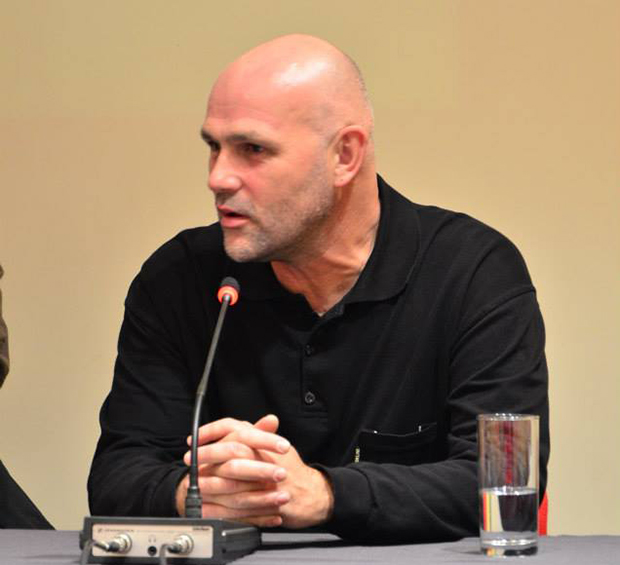
Sasa Lekovic, seen here at a Mediacentar Sarajevo event in 2013, spoke to Mapping Media Freedom about the changes at Croatia’s public broadcaster, HRT. (Photo: Mediacentar Sarajevo)
The cancellation of three radio programmes on 4 July by Croatia’s public broadcaster marks the latest in a line of sweeping changes the network has undergone since January 2016.
Two of the three shows — Audio.doc and Hidden Side of the Day — were produced by award-winning radio journalist Ljubica Letinic, while the third — Morning at Third — was considered to the Croatian Radio-Television’s (HRT) most popular. N1, a regional broadcaster, reported that the programmes will be replaced with new shows that are more appropriate to the ruling elite’s ideology, including one on Christian spirituality.
The changes at HRT have gathered momentum since Croatia’s new conservative government came to power in January 2016. More than 70 media workers at HRT have been demoted or fired and more than 10 TV and radio shows have been terminated, according to the Croatian Journalists’ Association, which has strongly condemned what it calls the deliberate destruction of HRT.
In a written response to the cancellations, CJA president Sasa Lekovic said Croatia’s minister of culture Zlatko Hasanbegovic is the force behind the “culturecide” at HRT and that the changes are motivated by the ideological differences between the conservative government and the liberal subdivisions at the public broadcaster.
In an interview with Mapping Media Freedom, Lekovic said that the purges at HRT were pre-announced, even before the conservative coalition government came to power.
“The latest developments were already announced,” Lekovic said, referring to two interviews. The first with the former Prime Minister Tomislav Karamarko from 2015, and the second with Hasanbegovic from 2013.
“Karamarko in his last year’s interview for weekly Globus announced how citizens, and especially journalist, will need to behave once he comes in power,” Lekovic said. After this it was reasonable to expect that Hasanbegovic will be in charge for media, especially after his statement that the public broadcaster’s channels are being used to enact a “post-modern, neo-Yugoslav deconstruction of Croatian national and cultural identity”.
The Croatian Writers’ Society (HDP) have also condemned the recent trend of deep and substantial changes in the public broadcaster accusing the actual government of “silencing critical voices”. Lekovic told Index on Censorship that the public broadcaster was totally devastated during Karamarko and Hasanbegovic’s brief tenure.
The coalition government between conservative center-right Croatian Democratic Union (HDZ) and the center party Most, a political platform comprised of independent local majors, was formed after more than two months of hard and erratic negotiations. By its nature it was an unstable and shaky coalition. Hasanbegovic as a high-ranking member of HDZ shortly after seated in the chair of the minister of culture. Immediately he became publicly known for series of scandals related to ideological and historical revisionism. One of the biggest scandals was revealed by the Croatian daily Novosti. They published an article that was written by Hasanbegovic during his student days in which he expressed sympathy for the fascist Ustasha regime in World War II Croatia.
After months of turbulence and scandals Karamarko resigned from the leader position at HDZ in June amid a corruption scandal that involved his wife. But briefly before his resignation, as a part of the intergovernmental power games, Karamarko and his party HDZ, which was the main party in the coalition, opted for a no-confidence vote for the government. The end result was Karamarko’s resignation from his position as the leader of the main ruling party, the failure of the coalition between HDZ and Most and snap elections were called for 11 September.
Despite the fact that the government lost the confidence vote, the changes at HRT continue as the broadcaster is under HDZ influence. In March, while still in power, the centre-right government installed Sinisa Kovacic, then-head of the parallel journalist association HNIP, as an acting head of HRT. Since then he has continued to implement Hasanbegovic’s vison for HRT and to reshape the broadcaster’s programmes. Since Kovacic was supposed to be in that position for maximum six months, a period that is long overdue, negotiations on his successor are underway.
Letinic said she is skeptical about the future of Croatian journalism. “It doesn’t look good, both for journalism and journalists. The paradox is that even such journalism serves this country. It was the weekly Nacional that provoked the fall of HDZ-MOST government.”
Mapping Media Freedom
|
Walking around the Zagreb offices of the Electronic Media Council (AEM), Croatia’s broadcast regulator, must have had a distinctive feel to it on 26 January. According to Croatian media, outside the building stood about 5,000 demonstrators singing Croatian patriotic songs, calling for AEM chair Marjana Rakic’s resignation and carrying an effigy of her dressed as a Yugoslav Partizan and holding a machine gun. Some shouted “Za dom spremni” (“For the homeland, ready”), a Nazi-style salute used by the Ustaše regime that ruled Croatia during World War II.
The reason? An episode of Markov Trg, a TV show created by Marko Juric and broadcast by Z1 TV, which AEM punished by suspending its license for three days over claims it was “inciting hatred on the basis of race and ethnicity”.
On 19 January, Markov Trg reported that Zagreb’s Serb Orthodox clergy routinely sang “Chetnik” songs.
As Balkan Transitional Justice notes, the word “Chetnik” has a few different connotations in the former Yugoslavia. “Originally applied to Serbian royalist fighters in World War II, it later became a more pejorative expression, even more so during the wars of the 1990s when many Serbian paramilitary groups styled themselves ‘Chetniks’.”
At the end of the show, anchor and direkto.hr columnist Marko Juric said: “The message to residents of Zagreb, to all those taking a stroll in Cvjetni Trg [one of the squares in downtown Zagreb], is to be careful, given that this is where the [Serb Orthodox] church led by a Chetnik vicar is located.
“Beware when you are walking down Cvjetnik Trg, especially mothers with children, because one of those Chetnik vicars could run out of the church and commit a slaughter in Zagreb’s most beautiful square.
“Maybe ‘Beware of Chetnik’ signs should be put up there.”
The statement prompted a disagreement in Croatian media.
The Croatian Journalists Association (HND) was quick condemn the show, as on 21 January its president Sasha Lekovic said in a statement that the show hadn’t done any journalistic work, and was instead “irresponsible and alarming public appearance”.
“We believe that all media should keep in mind at all times that there is a fine line between verbal and actual violence,” his statement reads.
One day later, on 22 January, the AEM found that Juric had incited hatred, and suspended Z1 TV’s license for three days between 26 and 29 January.
The Association of Croatian Journalists and Publicists (HNiP), a new Croatian press association, strongly condemned the decision to suspend the broadcaster, calling it an “unprecedented, serious attack on the freedom of the media and freedom of expression”. Marko Juric is a member of the HNiP.
After that the 26 January protest, which was organised by civil war veterans, who also strongly condemned the HND’s statement, claiming they were “attacking freedom of expression, instead of protecting it”.
According to HDN reports, veterans have also sent the association a letter which “endangers the safety of journalists”, which pairs with “verbal harassment” via phone and “hate speech”. HND also criticised Croatia’s right-wing government for failing to condemn the protest and the country’s vice president for actually joining the demonstration against the regulator.
The protest is one of the episodes of an ongoing disagreement in Croatian media, where HND and HNiP have been accusing each other of suffocating media freedom and lowering journalistic standards.
HNiP was launched on 2 July 2015 by journalists dissatisfied with HND standards and “lack of democracy and world-view balance in the media”, and counts 45 members.
HND is the biggest and oldest journalists’ association in the country. It was founded in 1910, counts about 3,000 members and has joined the International Federation of Journalists in 1992. HND’s Lekovic is critical of the HNiP’s integrity. Speaking to Index on Censorship in August 2015, Lekovic said that lack of professional integrity was one of the primary threats in the Croatian media landscape.
“We have a number of media outlets, especially web portals, not following any professional standard; they are actually using media freedom against the media,” he said.
After the Z1 TV case and the protest that followed it, the dispute continued with exchanges of accusations, the HNiP said Lekovic is trying to discredit them, while HND said HNiP is part of Prime Minister Karamanko’s plan to take over the media.
At the beginning of March 2016, Croatia’s government appointed Sinisa Kovacic, president of the HNiP, as a new acting director general at the public broadcaster Croatian Radiotelevision (HRT). Since then, around 15 editors and programme directors have been replaced at HRT.
There are also now suggestions that the government is trying to replace Rakic as AEM’s president.
On 4 March, Lekovic said in a statement: “They [members of the HNiP] want to neutralise the HND and introduce unprofessional and unethical conduct in journalism, and servility to the incumbent government as a desirable model of journalist work.”
Mapping Media Freedom
|
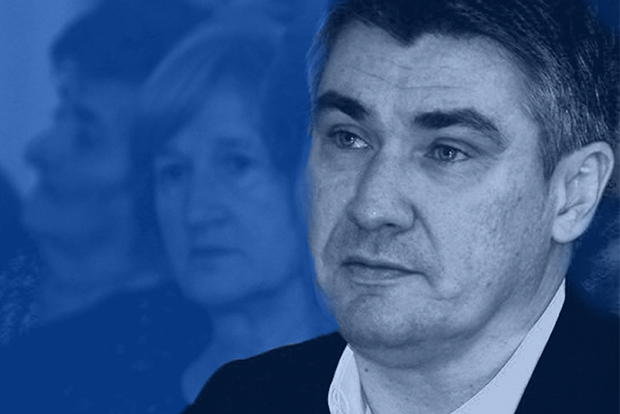
Croatian prime minister Zoran Milanović. Original image by SDP Hrvatske
A worrying escalation of attacks on the media in Croatia has been recorded by the Index’s Mapping Media Freedom project in the last three months. Since 1 September there have been 13 attacks, compared with 3 in the same period last year.
In August, we reported an increase in media violations in Croatia. Deaths, physical assaults and intimidation had been plaguing the Croatian media for months. Increasing violence is still undermining media freedom in Croatia.
Hannah Machlin, Index’s Mapping Media Freedom project officer, said: “The increasing amount of violence against Croatian journalists is quite alarming. In reaction to the migrant crisis, there’s been a particularly high number of cases on the Hungarian/Croatia border.”
The Croatian constitution guarantees freedom of expression and the press, and “these rights are generally respected in practice”. Freedom House does, however, acknowledge that journalists face political pressure, intimidation and the “occasional” attack. According to Freedom House, Croatia has been a “free” country for some years.
Below, Index on Censorship details some of the worst cases from Croatia since September.
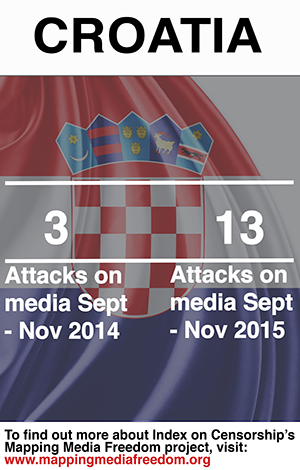
Overall attacks, including violence, intimidation, loss of employment and censorship of work
In early October, Croatia opened its border with Serbia, easing one of the main areas for congestion for refugees trying to make their way north. On 19 October, Mapping Media Freedom recorded that media workers were harassed and assaulted by Croatian police on the border near the Bapska-Berkasovo crossing. Regional N1 television reported that the Croatian police had also confiscated the journalists’ equipment.
“When they moved against me, I shouted that I was an AFP photojournalist and that their colleagues had checked my ID this morning,” Andreja Isakovic told N1. “They asked me to hand over the cards. One of them ran towards me, caught up with me and threw me into the mud. They took away my cameras in a savage manner and threw them into an orchard on the Croatian side, so I could not reach them. They did the same to my colleague from England.”
Croatian journalists condemn attack on two Greek journalists Dyonisios Verveles and George Stasinopoulos during coverage of #ChampionsLeague
— EFJ (@EFJEUROPE) October 21, 2015
In mid-October, two Greek journalists, George Stasinopoulos and Dionisis Verveles, were attacked by unidentified individuals while walking near a sporting event in Zagreb. Two men wearing face masks stopped the journalists on a street, asking them to identify themselves and their origin. When the two colleagues attempted to run away, they were attacked.
One journalist was beaten and the other was threatened by one of the assailants who was brandishing a knife. When the journalists began shouting that they were members of the press, the attackers fled the scene.
Velimir Bujanec, host of the controversial TV show Bujica, was verbally assaulted by Stipe Milanović, father of Croatian prime minister, Zoran Milanović. Gordan Malic, a local freelance investigative journalist based in Croatia, was also threatened. Around noon on 3 October in a coffee bar in the center of Zagreb, Stipe Milanović allegedly said that “Bujanec and Gordan Malic should be beaten up”. There were three witnesses to his comment.
Bujanec reported to the media and posted it on Facebook. After speaking with his lawyer, he also reported the incident to the police and is now reportedly pressing charges against Milanović for verbal assaults and threats.
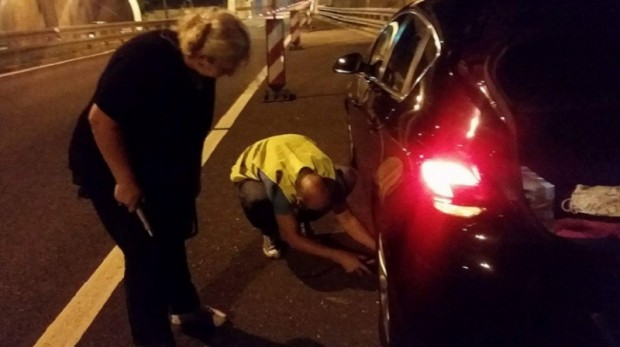
Credit: Serbian web portal Telegraf
Suzana Trninic is a journalist with the Serbian television broadcaster B92. On 24 September, while travelling to a media festival in Rovinj with Belgrade license plates on her car, she and her team stopped for coffee at a petrol station in Grobnik. When they returned, one of the car’s tires had been slashed.
There was visible sticker press on the vehicle, Trninic said. She did not want to report the incident to the police and media on the day as she did not want to distract from the ongoing border crisis between Serbia and Croatia.
Trninic believes the incident is connected with her being a Serbian journalist.
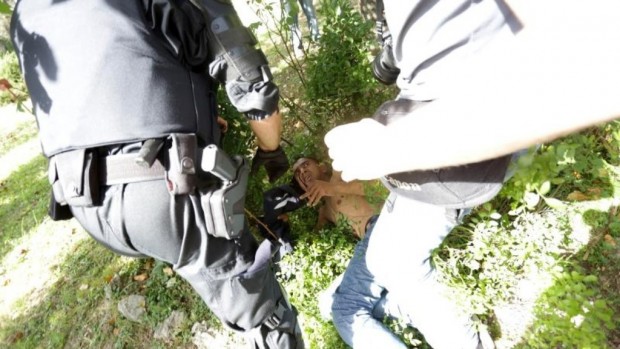
“I’ll kill you!” yelled the assailant as a stone hit the cameraman. Click image for video. Credit: Večernji.hr
On Thursday 17 September 2015, an asylum seeker from Kosovo began shouting threats and then threw a brick at the TV Mreza crew reporting at Hotel Porin. One cameraman was injured. The assailant was immediately restrained by other journalists until riot police arrived and detained him.
Hotel Porin is both a reception and registration centre where asylum applications are completed, including fingerprinting and medical examinations. As Croatian media has reported, almost all refugees are polite and grateful and all have the right to leave the hotel and walk around Dugavama.
Details of attacks on the media across Europe can be found at Index on Censorship’s Mapping Media Freedom website. Reports to the map are crowdsourced and then fact-checked by the Index team.
Mapping Media Freedom
|

Sasa Lekovic at a Mediacentar Sarajevo event in 2013 (Photo: Mediacentar Sarajevo)
Over the past few months, death threats, physical assaults and intimidation have plagued the Croatian media. This drastic deterioration of media freedom is recorded through Index’s Mapping Media Freedom. In the first year of the campaign — from May 2014 — there were 24 verified incidents in Croatia. Between May and August 2015, there were 14, a 75% rise in verified reports over the same period last year.
This surge in media violations was recently addressed by the Croatian Journalists’ Association (CJA) and an OSCE representative on Freedom of the Media. In a statement published on its website, the CJA highlighted impunity as one of the main issues hindering media freedom throughout the country. “The CJA once again calls on authorities to find and adequately punish those who have threatened and attacked journalists, and to also find those who potentially ordered the attacks.”
The primary concern of the CJA is the long line of unresolved cases surrounding death threats and attacks on journalists. Exactly one year since freelance journalist Domagoj Margetic was brutally beaten in front of his apartment in Zagreb — an attack the Croatian State Prosecution has characterised as attempted murder — information on the attacker and the motive remain absent. Other unresolved cases include that of Antonio Mlikota, graphic editor at the Hrvatski Tjednik newsroom who was bound and threatened with a gun, and Hrvoje Simicevic, a journalist at H-Alter who was physically assaulted. There was also a series of death threats addressed to Katarina Maric Banje, a journalist for Slobodna Dalmancija, Drago Pilsel, editor-in-chief of the Autograf website, and Sasa Lekovic, the president of the CJA, along with others that have not been made public.
In light of the influx of violence, Index spoke to Lekovic, who also received a death threat. Lekovic assumes it was issued as a result of his new role, adding that the CJA makes people who want to control the media very nervous.
Discussing the most prominent threats to media freedom, he emphasised that “journalists in Croatia are under mixed pressure from politicians, media owners, mighty tycoons and organised crime.” Lekovic says this is not particularly new, adding that for almost two decades journalists have been subjected to such threats. “Generally speaking, it isn’t easy to discern the small distinction between these actors, if any.”
Although the primary threat to media freedom is self-censorship, the lack of media integrity is also a problem. “On one hand, we have a number of media outlets, especially web portals, not following any professional standard; they are actually using media freedom against the media,” Lekovic told Index. “On the other hand, we also have some laws that are used against professionals to suspend their right to serve public interest.”
In recent years, the CJA has taken multiple steps towards fostering a more relaxed and professional environment for media workers. Among other measures, they started a project called The Center for Protection of Public Speech.
“We have lawyers who are helping journalists that are in danger, including providing pro bono support and court representation. On the other hand, the CJA is going to work on ideas that better media legislation and their implementation and ones that will improve media literacy and training,” Lekovic says. “It’s all connected and is a long-term job that will not be completed overnight.”
On deteriorating media freedom, Lekovic says the current climate is notably worse than it was two years ago. He explains that “when Croatia was applying to become an EU member, it was under pressure to fulfill EU legislative requirements within the media sphere, but once the country joined the EU, nobody cared about upholding them”.
The OSCE Representative on Freedom of the Media, Dunja Mijatovic, has called on Croatian authorities to protect critical voices and to investigate the increase in attacks on journalists. Mijatovic wrote to Croatia’s Foreign Minister, Vesna Pusic, calling for swift and transparent investigations.
“As far as I am aware, all these cases remain unresolved,” Mijatovic wrote. “Condemnation coming from the highest level of government should be a clear sign that these acts of intimidation and violence against journalists will not be tolerated.”
Lekovic added that Croatia’s upcoming parliamentary election due by February 2016 is adding to the pressure.
Mapping Media Freedom
|
Related:
• Croatia: 35 reports since May 2014
This article was published at indexoncensorship.org on 28/8/2015